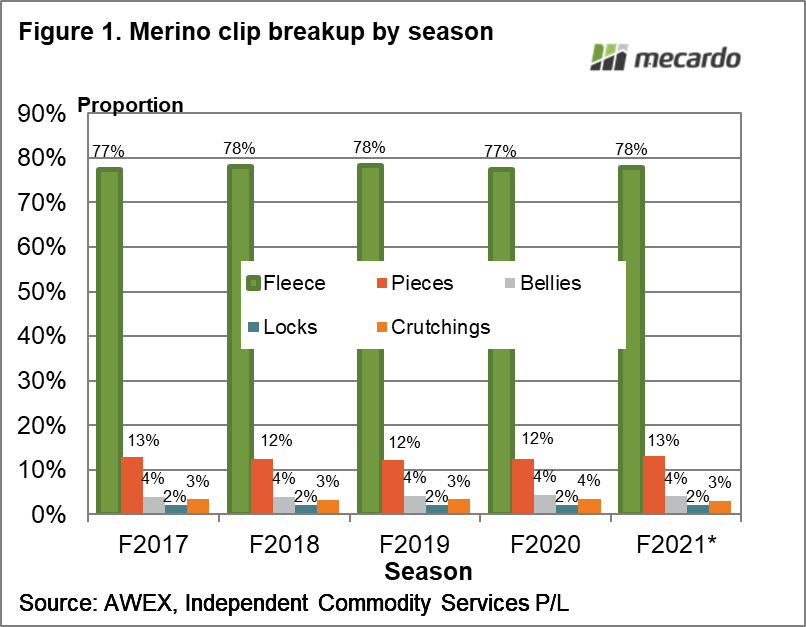The shrinkage in discounts for poorer specifications in the past decade has taken pressure off clip preparation in terms of maximising the proportion of fleece packaged (in farm bales) for sale. This article takes a brief look at the different proportions of the Australian Merino clip and their relative value in recent seasons.
So, how much of the Merino clip is presented for sale as fleece? Figure 1 shows the proportions, using clean wool for the calculations, of the Merino clip by category (fleece, pieces, bellies, locks and crutchings) sold in Australia for the current season to date and the previous four seasons. The proportions are very stable with 77-78% of the Merino clip sold as fleece, and 12-13% as pieces.
Table 1 averages out the data shown in Figure 1 and also shows similar averages for crossbred, downs and carpet wool sold in Australia during the past four and one half seasons. The proportions were calculated using clean wool volumes for each season and then averaged. On average some 78% of the Merino clip was sold as fleece, 13% as pieces (a six to one ratio of fleece to pieces), 4% as bellies, 2% as locks and 3.4% as crutchings. For crossbred wool there is less pieces, which allows the proportion of fleece to be higher, at 85%.
In Table 2 the price for each category is expressed as a weighted average of the price expressed as a percentage of the appropriate MPG (calculated to 0.1 micron for each lot sold). In mid-2019, when the micron price curve was flat, Table 2 allowed a quick guide to the relative value of the different categories. For example, Merino locks have sold for 59% of the MPG while fleece averaged 95.9%.
The increase in micron premiums and discounts which Mecardo last looked at a couple of weeks ago complicates the interpretation of Table 2. Table 3 shows why this is the case. It shows the average difference in micron between the different categories for each breed, using fleece as the base fibre diameter. For Merino wool pieces on average are 0.9 micron finer than the fleece while bellies are only 0.3 micron finer. Crutchings tend to be broader. In the current market 0.9 micron can make a lot of difference to the price of the wool, so the categories in Table 2 are operating on quite different base prices (MPGs) currently.
In practice the category proportions vary between regions and type of sheep. For example, fine wool sheep tend to have higher levels of locks, and clips with heavy vegetable fault will have more pieces. Wool needs to be prepared according to the AWEX Code of Practice as preparation quality is a basic piece of marketing, something the Australian crossbred clip has let slip in the past decade.
What does it mean?
In the current market knitwear is king and worsted is struggling, hence the small discounts for low staple strength and short staple length. Good pieces are selling for 93-92% of their MPG while low strength fleece is selling for 99-97% of its MPG – little difference except that pieces are nearly one micron finer which can increase the base price considerably. In the fray of shearing it can be easy to let standards slip but quality of preparation is important to the price of a lot and to the Australian clip in the longer run. There is no point in spending money on marketing if the preparation and packaging is poor.
Have any questions or comments?
Key Points
- The breakup of the various clips in Australia, into their constituent categories, is fairly stable between seasons.
- Some 78% of the Merino clip is sold as fleece in clean terms and about 13% as pieces.
- Merino pieces as a rule of thumb are 0.9 micron finer than the average fleece micron, while bellies are 0.3 micron finer.
- The relative value of prices to fleece varies with micron and premiums and discounts and the relative strength of knitwear versus worsted.
Click on figure to expand
Click on figure to expand
Click on figure to expand
Data sources: AWEX, ICS, Mecardo





